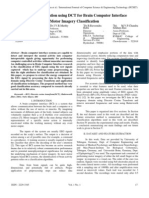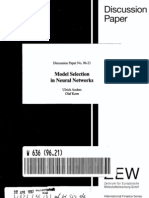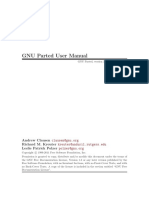Probabilistic Machine Learning: Advantages of Using Probabilistic Models
Probabilistic Machine Learning: Advantages of Using Probabilistic Models
Uploaded by
qpwo10Copyright:
Available Formats
Probabilistic Machine Learning: Advantages of Using Probabilistic Models
Probabilistic Machine Learning: Advantages of Using Probabilistic Models
Uploaded by
qpwo10Original Description:
Original Title
Copyright
Available Formats
Share this document
Did you find this document useful?
Is this content inappropriate?
Copyright:
Available Formats
Probabilistic Machine Learning: Advantages of Using Probabilistic Models
Probabilistic Machine Learning: Advantages of Using Probabilistic Models
Uploaded by
qpwo10Copyright:
Available Formats
Machine learning research
Page 1 of 3
Probabilistic machine learning
Unlike other methods probabilistic machine learning is based on one consistent principle which is used throughout the entire inference procedure. Probabilistic methods approach inference of latent variables, model coefficients, nuisance paramaters and model order esentially by applying Bayesian Theory. Hence we may treat all unkown variables identically which is mathematically nice. For computational reasons a fully probabilistic model might not be feasible. In such situations we have to use approximations. Obviously for an emprirical methodology, a mathematical consistency argument is not too convincing. So why should one use probabilistic methods?
Advantages of using probabilistic models
Fully probabilistic models avoid "black box" characteristics. We may instantiate arbitrary sets of variables and for diagnosis purpouses infer the distributions over (or expectations of) other variables of interst and thus obtain some insight how we obtain a particular decision. Using a probabilistic model is relatively easy. Inference (if properly implemented) should be insensitive to the setting of all "fiddle parameters" and will thus provide results that are close to optimal. An example that relies on this property is adaptive inference which I have used for our adaptive BCI. Probabilistic models provide means for intelligent sensor fusion which allows e.g. to combine information that is known with different certainty.
Disadvantages of using probabilistic models
Inference of fully probabilistic models can be slow. Infering probabilistic models inevitably requires to model distributions. Sometimes this can be more than we are asked for.
Bayesian sensor fusion
was the topic of a talk I gave recently at the NCRG in Aston, with a pdf version of the slides beeing available here. I want to thank Peter Tino for the invitation and all atendees for their feedback.
The basic idea of Bayesian sensor fusion is to take uncertainty of information into account. In machine learning the seminal papers were those by (MacKay 1992) who discussed the effects of model uncertainty. In (Wright 1999) these ideas were later extendend to input uncertanty. Very much related is the work by (Dellaportas & Stephens 1995) who discuss models for errors in observeables. I got interested in these issues in the context of hierarchical models where model parameters of a feature extraction stage are used for diagnosis or segmentation purpouses. Such models are e.g. used for sleep analsysis or also in the context of BCI. In a Bayesian sense these features are latent variables and should be treated as such. Again this is a consistency argument which has to be examined for its practical relevance. In order to obtain a hierarchical model that does sensor fusion we simply regard the feature extraction stage as latent space and integrate (marginalize) over all uncertainties. The left figure compares a sensor fusing DAG with current practice in many applications of
http://www.robots.ox.ac.uk/~psyk/research.html
3/8/2011
Machine learning research
Page 2 of 3
probabilistic modeling that regard extracted features as observations. I reported on a first attempt to approach this problem in (Sykacek 1999) which is in more detail described in section 4 in my Ph.D. thesis. In order to see that a latent feature space has practical advantages, we consider a very simple case where two sensors are fused in a naive Bayes manner to predict the posterior probability in a two class problem. The model is similar to the one in the graph used above, however with two latent feature stages that are, conditional on the state of interest t, assumed to be independent. The plot on the right illustrates the effect of knowing one of the latent features with varying precision. Conditioning on a best estimate results obviously in probabilities that are independent of the precision. We hence obtain a flat line at probability P(2)=0.27. Marginalization modifies the probabilities wich can, as we see, also modify the predicted state. We may thus expect to obtain improvements in cases where the precision of the distributions in the latent feature space varies. We have successfully applied a HMM based latent feature space model to classification of segments of multi sensor time series. Such problems arise in clinical diagnosis (sleep classification) and in the context of brain computer interfaces (BCI). A MCMC implementation and evaluation on synthetic and BCI data has been published in (Sykacek & Roberts 2002a). Recently (Beal etal 2002) have applied similar ideas to sensor fusion of audio and video data.
References
(MacKay 1992) D. J. C. MacKay. Bayesian interpolation. in Neural Computation, pages 415-447, 1992. (Bernardo & Smith 1994) J. M. Bernardo and A. F. M. Smith. Bayesian Theory. John Wiley & Sons, Chichester UK, 1994. (Dellaportas & Stephens 1995) P. Dellaportas and S. A. Stephens. Bayesian analysis of errors-in-variables regression models. Biometrics, 51:1085-1095, 1995. (Wright 1999) W. A. Wright. Bayesian approach to Neural-Network modeling with input uncertainty. IEEE Trans. Neural Networks, 10:1261-1270, 1999. (Sykacek 1999) Learning from uncertain and probably missing data. Peter Sykacek, OEFAI. An abstract is available on the workshop homepage. (Beal etal. 2002) M. J. Beal, H. Attias and N. Jojic. A Self-Calibrating Algorithm for Speaker Tracking Based on Audio-Visual Statistical Models. In Proc. Int. Conf. on Acoustics Speech and Signal Proc.
http://www.robots.ox.ac.uk/~psyk/research.html
3/8/2011
Machine learning research
Page 3 of 3
(ICASSP), May 2002.
http://www.robots.ox.ac.uk/~psyk/research.html
3/8/2011
You might also like
- HPC Mini Project ReportDocument12 pagesHPC Mini Project ReportKetan Ingale100% (1)
- Practical Bayesian InferenceDocument322 pagesPractical Bayesian InferenceSinisa Hristov100% (1)
- Bayesian Modeling Using The MCMC ProcedureDocument22 pagesBayesian Modeling Using The MCMC ProcedureKian JahromiNo ratings yet
- Ghahramani 2015 Nature PDFDocument24 pagesGhahramani 2015 Nature PDFNîKüñj DøbåríÿâNo ratings yet
- Nature 14541Document8 pagesNature 14541sfzhong123No ratings yet
- Comparison of Naive Bayes Classifier and C-LSTMDocument6 pagesComparison of Naive Bayes Classifier and C-LSTMK Prathvi RaoNo ratings yet
- Semantics and Thermodynamics: James P. CrutchfieldDocument38 pagesSemantics and Thermodynamics: James P. CrutchfieldrezapouNo ratings yet
- Conclusions and Future WorkDocument12 pagesConclusions and Future WorkashishkkrNo ratings yet
- An Overview of Advances of Pattern Recognition Systems in Computer VisionDocument27 pagesAn Overview of Advances of Pattern Recognition Systems in Computer VisionHoang LMNo ratings yet
- Nips CkiwDocument8 pagesNips CkiwmikeNo ratings yet
- RJwrapperDocument24 pagesRJwrapperTyan OrizaNo ratings yet
- Mixture Models and ApplicationsFrom EverandMixture Models and ApplicationsNizar BouguilaNo ratings yet
- 3481 PDFDocument8 pages3481 PDFChikh YassineNo ratings yet
- Bcia Cia2Document14 pagesBcia Cia2crickethub428No ratings yet
- Tracking Context Changes Through Meta-Learning: Editors: Ryszard S. Michalski and Janusz WnekDocument28 pagesTracking Context Changes Through Meta-Learning: Editors: Ryszard S. Michalski and Janusz WnekbisemaNo ratings yet
- 37316Document4 pages37316yesaya.tommyNo ratings yet
- Prop LPTMS ROSSO 2023-Apr-21 1631Document3 pagesProp LPTMS ROSSO 2023-Apr-21 1631Assal yassineNo ratings yet
- Uncertainty ModellingDocument7 pagesUncertainty ModellingOkky WarmanNo ratings yet
- Energy Computation Using DCT For Brain Computer Interface Motor Imagery ClassificationDocument4 pagesEnergy Computation Using DCT For Brain Computer Interface Motor Imagery ClassificationchakriNo ratings yet
- Inference For SDE Models Via Approximate Bayesian ComputationDocument27 pagesInference For SDE Models Via Approximate Bayesian ComputationLý Nguyễn Kỳ DuyênNo ratings yet
- SpaceStat Chapter2Document44 pagesSpaceStat Chapter2fsjf2rn9jwNo ratings yet
- Journal of Statistical Software: A MATLAB Package For Markov Chain Monte Carlo With A Multi-Unidimensional IRT ModelDocument20 pagesJournal of Statistical Software: A MATLAB Package For Markov Chain Monte Carlo With A Multi-Unidimensional IRT ModelBetoNo ratings yet
- Markov Chain Monte Carlo Simulation in RDocument14 pagesMarkov Chain Monte Carlo Simulation in RTito MazolaNo ratings yet
- Article ANN EstimationDocument7 pagesArticle ANN EstimationMiljan KovacevicNo ratings yet
- Class Imbalance Should Not Throw You Off Balance - Choosing The Right Classifiers and Performance Metrics For Brain Decoding With Imbalanced DataDocument14 pagesClass Imbalance Should Not Throw You Off Balance - Choosing The Right Classifiers and Performance Metrics For Brain Decoding With Imbalanced DataNourhane CHEBABNo ratings yet
- NeuroimagingDocument19 pagesNeuroimagingmikeNo ratings yet
- Cableado EstructuradoDocument17 pagesCableado EstructuradoJeferson MorenoNo ratings yet
- Machine Learning Techniques Assignment-7: Name:Ishaan Kapoor Rollno:1/15/Fet/Bcs/1/055Document5 pagesMachine Learning Techniques Assignment-7: Name:Ishaan Kapoor Rollno:1/15/Fet/Bcs/1/055bharti goyalNo ratings yet
- Alkhatib Et Al - 2022 - Assessing Explanation Quality by Venn PredictionDocument13 pagesAlkhatib Et Al - 2022 - Assessing Explanation Quality by Venn Predictionwenk.sitterding.opcNo ratings yet
- Think Globally, Fit LocallyDocument33 pagesThink Globally, Fit LocallyAli Umair KhanNo ratings yet
- (Weinan, E., Chao Ma, and Lei Wu), Machine Learning From A Continuous Viewpoint, I, Science China Mathematics 63.11 (2020) - 2233-2266.Document34 pages(Weinan, E., Chao Ma, and Lei Wu), Machine Learning From A Continuous Viewpoint, I, Science China Mathematics 63.11 (2020) - 2233-2266.Aman JalanNo ratings yet
- An Introduction To Thermodynamic Integration and Application To Dynamic Causal ModelsDocument15 pagesAn Introduction To Thermodynamic Integration and Application To Dynamic Causal ModelsDaniela MagalhãesNo ratings yet
- Deep Learning Based Soft Sensor and Its Application On A Pyrolysis Reactor For Compositions Predictions of Gas Phase ComponentsDocument6 pagesDeep Learning Based Soft Sensor and Its Application On A Pyrolysis Reactor For Compositions Predictions of Gas Phase Componentsmice LiNo ratings yet
- Crftut FNT PDFDocument109 pagesCrftut FNT PDFrilfiunNo ratings yet
- Question Bank 3&4 Unit MLDocument6 pagesQuestion Bank 3&4 Unit MLjagadeeswaris.aiNo ratings yet
- A Novel Intuitionistic Fuzzy Rough Instance Selection and A - 2024 - Expert SystDocument15 pagesA Novel Intuitionistic Fuzzy Rough Instance Selection and A - 2024 - Expert SystmvictorrajmechanicalNo ratings yet
- 01 PP 003Document28 pages01 PP 003enrico_britaiNo ratings yet
- Methods For Meta-Analysis and Meta-Regression of PDocument26 pagesMethods For Meta-Analysis and Meta-Regression of PKwame GogomiNo ratings yet
- First PaperDocument4 pagesFirst Paperachaparala4499No ratings yet
- ML Unit5Document14 pagesML Unit5aiswaryaNo ratings yet
- SSCI16 Paper 394Document10 pagesSSCI16 Paper 394shiennasNo ratings yet
- I-:'-Ntrumsu'!I: Model Selection in Neural NetworksDocument27 pagesI-:'-Ntrumsu'!I: Model Selection in Neural Networksniwdex12No ratings yet
- Deep Learning AnswersDocument36 pagesDeep Learning AnswersmrunalNo ratings yet
- Project ReportDocument35 pagesProject ReportArpit Sharma100% (1)
- Statistics NotesDocument16 pagesStatistics NotesAnimesh Sah • 15 years ago • UpadatedNo ratings yet
- 1 NN in Cap Mkts Refenes Ch01 IntroDocument7 pages1 NN in Cap Mkts Refenes Ch01 Introporapooka123No ratings yet
- Probabilistic Models in Machine Learning: Unit - III Chapter - 1Document18 pagesProbabilistic Models in Machine Learning: Unit - III Chapter - 1AnilNo ratings yet
- Mastering Probabilistic Graphical Models Using Python - Sample ChapterDocument36 pagesMastering Probabilistic Graphical Models Using Python - Sample ChapterPackt PublishingNo ratings yet
- Journal of Statistical Software: Mice: Multivariate Imputation by Chained Equations in RDocument67 pagesJournal of Statistical Software: Mice: Multivariate Imputation by Chained Equations in RcinculiranjeNo ratings yet
- Smni06 Ppi PDFDocument21 pagesSmni06 Ppi PDFLester IngberNo ratings yet
- Application of Multiplicative Dimensional Reduction Method For Uncertainty Quantification and Sensitivity Analysis of MEMS Electrostatic ActuatorsDocument7 pagesApplication of Multiplicative Dimensional Reduction Method For Uncertainty Quantification and Sensitivity Analysis of MEMS Electrostatic ActuatorsrkneskrniNo ratings yet
- Journal of Statistical Software: Multiple Imputation With Diagnostics (Mi) in R: Opening Windows Into The Black BoxDocument31 pagesJournal of Statistical Software: Multiple Imputation With Diagnostics (Mi) in R: Opening Windows Into The Black BoxAbi ZuñigaNo ratings yet
- Abstraction, Refinement and Proof For Probabilistic Systems - 2005 - Annabelle McIver - Carroll MorganDocument395 pagesAbstraction, Refinement and Proof For Probabilistic Systems - 2005 - Annabelle McIver - Carroll MorganJESUS ELVIS CASTAÑEDA CASTILLONo ratings yet
- Best Generalisation Error PDFDocument28 pagesBest Generalisation Error PDFlohit12No ratings yet
- A Face Recognition Scheme Based On Principle Component Analysis and Wavelet DecompositionDocument5 pagesA Face Recognition Scheme Based On Principle Component Analysis and Wavelet DecompositionInternational Organization of Scientific Research (IOSR)No ratings yet
- Need of PCADocument6 pagesNeed of PCASimi Jain100% (1)
- Unsupervised Neural NetworksDocument30 pagesUnsupervised Neural Networksapi-19937584No ratings yet
- Convergence and Errors PDFDocument13 pagesConvergence and Errors PDFMohit1234zxtNo ratings yet
- Learning Multiple Layers of Representation: Geoffrey E. HintonDocument7 pagesLearning Multiple Layers of Representation: Geoffrey E. HintonVănAnhNo ratings yet
- A Tutorial On Principal Component AnalysisDocument16 pagesA Tutorial On Principal Component AnalysisTaylorNo ratings yet
- WorkEnergy P2Document26 pagesWorkEnergy P2dhairya gandhi100% (1)
- Srikanth Reddy Vaddepally CVDocument3 pagesSrikanth Reddy Vaddepally CVv_srikanth961No ratings yet
- Project Performance Report (Final Report) English - YER 2022Document19 pagesProject Performance Report (Final Report) English - YER 2022Gile ŠampionNo ratings yet
- HIS343 2012 SyllabusDocument18 pagesHIS343 2012 Syllabuspewpew13No ratings yet
- Bromley-Charles Babbage's Analytical EngineDocument22 pagesBromley-Charles Babbage's Analytical EnginelosoloresNo ratings yet
- Unit-4: - Design Axioms - Designing Classes - Access Layer - Object Storage - Object InteroperabilityDocument56 pagesUnit-4: - Design Axioms - Designing Classes - Access Layer - Object Storage - Object Interoperabilitynetrapp100% (2)
- Unifier Integration Interface v19Document478 pagesUnifier Integration Interface v19Fernanda Gerevini Pereira100% (1)
- Marsilio Ficino and Renaisance of PlatonismDocument7 pagesMarsilio Ficino and Renaisance of PlatonismFelipe AguirreNo ratings yet
- VI Io GuideDocument413 pagesVI Io GuideewrNo ratings yet
- Liquid ModernityDocument17 pagesLiquid ModernityDISCAYA LAIKA100% (1)
- GNU Parted User Manual: Andrew Clausen Richard M. Kreuter Leslie Patrick PolzerDocument26 pagesGNU Parted User Manual: Andrew Clausen Richard M. Kreuter Leslie Patrick PolzerShaun RobertsonNo ratings yet
- Henry James "..Any Point of View Is Interesting That Is A Direct Impression of LIFE."Document14 pagesHenry James "..Any Point of View Is Interesting That Is A Direct Impression of LIFE."salads cloudsNo ratings yet
- Thai Proverb ProjectDocument13 pagesThai Proverb Projectapi-343714827No ratings yet
- An Introduction To A House For MR Biswas PDFDocument6 pagesAn Introduction To A House For MR Biswas PDFSarba WritesNo ratings yet
- Instincts of The Herd in Peace and War - Wilfred TrotterDocument3 pagesInstincts of The Herd in Peace and War - Wilfred TrotterCristi IrimiaNo ratings yet
- HcdsDocument23 pagesHcdsSumathi VenkateshNo ratings yet
- 2015 VMP TemplateDocument10 pages2015 VMP Templatekulbhushan singh100% (2)
- Assignment NeuralNetworkDocument8 pagesAssignment NeuralNetworkSandhya KuppalaNo ratings yet
- Design of Reinforced Concrete Deep Beams For Strength andDocument390 pagesDesign of Reinforced Concrete Deep Beams For Strength andWallen Jusri SihotangNo ratings yet
- Klintoe PDFDocument31 pagesKlintoe PDFVelmurugan KNo ratings yet
- Creating A Solid Mesh: ExerciseDocument4 pagesCreating A Solid Mesh: ExerciseGopal VamssiNo ratings yet
- Client Credentials FlowDocument10 pagesClient Credentials FlowAnonymous 1U2FukcNo ratings yet
- 07 SelectionMethods 28pDocument28 pages07 SelectionMethods 28paqas_khanNo ratings yet
- Belousov-Zhabotinsky ReactionDocument4 pagesBelousov-Zhabotinsky Reaction沈益No ratings yet
- Tabadu Installation Steps: OBIEE 11.1.1.9 - Linux ODI 11.1.9 - Linux OBIA 11.1.1.10.1 - LinuxDocument66 pagesTabadu Installation Steps: OBIEE 11.1.1.9 - Linux ODI 11.1.9 - Linux OBIA 11.1.1.10.1 - LinuxSherif MohamedNo ratings yet
- Introduction To Programming With BasicDocument140 pagesIntroduction To Programming With BasicMalachy EziechinaNo ratings yet
- BP080 Future Process ModelDocument10 pagesBP080 Future Process ModelparcanjoNo ratings yet
- The Grande Challeng of ConsciousnessDocument3 pagesThe Grande Challeng of Consciousnessalelex88No ratings yet
- SROW2 Robot Series PDFDocument193 pagesSROW2 Robot Series PDFIndra FardianNo ratings yet
- Elemen Mesin I (TMS 309) Pertemuan IDocument16 pagesElemen Mesin I (TMS 309) Pertemuan IAldo JennerNo ratings yet

























































































